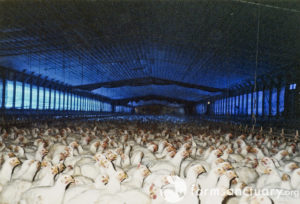By Katrien Devolder
Why do we force animals into close contact with each other, and with humans, while encouraging or even requiring humans to keep apart? Dangerous viruses do not distinguish between human and non-human vectors, so why do we?
 The vast majority of countries affected by the Covid-19 pandemic have adopted social distancing measures ranging from rules dictating how close we may be to each other, to bans on indoor gatherings, to closures of schools and workplaces, to travel bans. These measures have come at a significant cost—to the economy, to our mental health, and to our relationships. But they have saved, and are still saving, many lives. In many cases, these measures are therefore widely considered justified and indeed of the utmost importance.[1]
The vast majority of countries affected by the Covid-19 pandemic have adopted social distancing measures ranging from rules dictating how close we may be to each other, to bans on indoor gatherings, to closures of schools and workplaces, to travel bans. These measures have come at a significant cost—to the economy, to our mental health, and to our relationships. But they have saved, and are still saving, many lives. In many cases, these measures are therefore widely considered justified and indeed of the utmost importance.[1]
But if social distancing is crucial in confronting pandemics, why do we restrict it to humans? After all, many of the most dangerous infectious diseases (including SARS, MERS, HIV-AIDS, and very likely Covid-19) originated in animals and were then transmitted to humans. Each year, such ‘zoonotic’ diseases infect one billion people and cause millions of deaths.[2] If dangerous viruses do not distinguish between human and non-human vectors, why do we?
Obviously, the risk of animal to human virus transmission is vastly increased the closer and the more frequent the physical contact between humans and animals, yet we increasingly capture and trade wild animals, encroach on their habitats, and keep billions of animals for food production.
 Let’s focus on the latter: at any one time, there are billions of animals in factory farms, in close proximity to agricultural workers, and—of course—in close proximity to each other. The conditions the animals live and die in are highly conducive to zoonotic diseases. In the early 2000s, it was discovered that people working with farmed chickens were spreading a dangerous strain of avian influenza (HPAI H5N1) that so far is not very contagious, but kills 60% of people who test positive for the infection.[3] In 2009/2010, the (H1N1) swine flu pandemic killed between 151,700 and 575,400 people worldwide.[4] This pandemic was caused by a new and more deadly strain of a virus that was first identified in a factory farm for pigs in North Carolina.
Let’s focus on the latter: at any one time, there are billions of animals in factory farms, in close proximity to agricultural workers, and—of course—in close proximity to each other. The conditions the animals live and die in are highly conducive to zoonotic diseases. In the early 2000s, it was discovered that people working with farmed chickens were spreading a dangerous strain of avian influenza (HPAI H5N1) that so far is not very contagious, but kills 60% of people who test positive for the infection.[3] In 2009/2010, the (H1N1) swine flu pandemic killed between 151,700 and 575,400 people worldwide.[4] This pandemic was caused by a new and more deadly strain of a virus that was first identified in a factory farm for pigs in North Carolina.
The risk that the next pandemic will begin in a factory farm is high. [5] But why then do we force animals into close contact with each other, and with humans, while encouraging or even requiring humans to keep apart?[6] We should urgently contemplate including animals in our social distancing measures.
In fact, the case for applying social distancing measures to animals, in this case farm animals, is even stronger than the case for applying them to humans.
In humans, the downsides of social distancing are considerable: it infringes our right to freedom of movement. It restricts our travel, our social gatherings, our leisure activities. The more drastic social distancing measures such as quarantine, lockdowns, closures of childcare facilities, schools, universities and workplaces, and cancellation of mass gatherings and events have an enormous mental, social and economic impact.[7] But moving animals to farms where they have more space would be to their benefit; it would have positive effects on their quality of life, and their health. And compared to the status quo their freedom of movement would be increased, not restricted.
Of course, though the animals would clearly benefit, the agricultural industry would not; it would suffer financially. Indeed, applying social distancing measures to farm animals would probably put many companies involved in factory farming out of business. But ultimately other forms of farming would spring up to replace factory farming—forms of farming that are better for animals, human health, and the planet. Thus, the costs to the agricultural industry would largely be time-limited transition costs, whereas the benefits, in the form of reduced infectious disease, would be ongoing.
Perhaps it could be argued that social distancing in humans is more urgent than social distancing in non-human animals. In humans, social distancing is currently being used to contain the spread of an existent pandemic, whereas in animals it would be used to prevent the emergence of ‘some’ virus that ‘could’ give rise to a pandemic. This would be like socially distancing people as a precautionary measure to prevent a new pandemic arising, and it’s not clear that such precautionary distancing would be accepted.
However, the reason why we would be reluctant to implement human social distancing measures before a pandemic arises is that these measures come at a significant cost. This is not the case for implementing social distancing measures among farm animals.
Moreover, there have, in fact, been calls to take a more pre-emptive approach when it comes to implementing social distancing measures in humans. It has been argued that we should implement social distancing measures as a preventative measure when transmission is only suspected or anticipated, because at this point even mild distancing measures could have significant benefits.[8] And now that human societies have experience with distancing, it is quite conceivable that these arguments will gain traction. If mild, pre-emptive social distancing measures are indeed accepted in humans, it is hard to see how we could consistently reject them for animals.
The risk that the next pandemic will begin in a factory farm is high. Social distancing between animals, and between animals and humans is non-existent in these industrial settings. If we agree human social distancing measures are a crucial tool in preventing and tackling pandemics, we should urgently extend these measures to animals. We should do as viruses do and treat animals and humans the same.The risk that the next pandemic will begin in a factory farm is high. Social distancing between animals, and between animals and humans is non-existent in these industrial settings. If we agree human social distancing measures are a crucial tool in preventing and tackling pandemics, we should urgently extend these measures to animals. We should do as viruses do and treat animals and humans the same.
(PS: perhaps we should start using #SocialDistancingForAnimals when discussing this topic on social media!)
References:
[1] Thunström, L., Newbold, S., Finnoff, D., Ashworth, M., & Shogren, J. (2020). The Benefits and Costs of Using Social Distancing to Flatten the Curve for COVID-19. Journal of Benefit-Cost Analysis, 11(2), 179-195. doi:10.1017/bca.2020.12.
[2] WHO EMRO. Zoonotic disease: emerging public health threats in the Region http://www.emro.who.int/about-who/rc61/zoonotic-diseases.html (accessed 9 Oct 2020).
[3] Centers for Disease Control and Prevention (CDC). Highly Pathogenic Asian Avian Influenza A(H5N1) in People. https://www.cdc.gov/flu/avianflu/h5n1-people.htm (accessed 9 Oct 2020).
[4] Centers for Disease Control and Prevention (CDC) 2009 H1N1 Pandemic (H1N1pdm09 virus). https://www.cdc.gov/flu/pandemic-resources/2009-h1n1-pandemic.html (accessed 11 Oct 2020).
[5] Hollenbeck, J.E.(2015). Interaction of the role of Concentrated Animal Feeding Operations (CAFOs) in Emerging Infectious Diseases (EIDS). Infect Genet Evol 38:44-46. Humane Society International (Sept 2020). An HSI report: The connection between animal agriculture, viral zoonoses, and global pandemics. https://blog.humanesociety.org/wp-content/uploads/2020/10/Animal-agriculture-viral-disease-and-pandemics-FINAL-4.pdf. (accessed 13 Oct 2020).
[6] A question also posed by Jonathan Safran Foer and Aaron S Gross in ‘We have to wake up: factory farms are breeding grounds for pandemics’, The Guardian (20 April 2020). https://www.theguardian.com/commentisfree/2020/apr/20/factory-farms-pandemic-risk-covid-animal-human-health.
[7] Dalton C.B., Corbett, S.J., Katelaris A.L. et al. Pre-emptive low cost social distancing and enhanced hygiene implemented before local COVID-19 transmission could decrease the number and severity of cases. The Medical Journal of Australia. https://www.mja.com.au/system/files/2020-03/FINAL%20Dalton%20preprint%20mja20.00300.pdf
[8] Ibid.

I totally agree on this. The public health benefits of social distancing for animals would be huge,. Social distancing for animals would actually address a broader range of issues. Lower infection rates would mean less need for antibiotics, thus reducing the contribution of animal farming to antibiotic resistance. Lower animal density would mean lower environmental impact of meat and dairy production.
As for the objection about the economic cost of this change, animal farming produces negative externalities, including for public health, that at the moment are not really factored in to the price of its products. With this kind of social distancing, meat would become more expensive than it is now. But that is because now it is too cheap: what is not factored into the price of animal products is paid by all of us in other ways, including increased risks of infectious disease. But it is those who regularly consume meat who are responsible for this. One solution could then be to make them pay for the externalities they impose on everyone, for example through a tax on meat. Revenue could then be used to subsidize the transition to the kind of animal farming advocated in the post, so as to minimize the risk that producers would be put out business.
Thanks Alberto! Yes I think a tax on meat would be a good idea for the reasons you mention. Also, I don’t know the figures, but currently the meat/dairy/egg industry must receive enormous subsidies. I wonder whether these could be made more conditional on the industry transitioning to more sustainable practices.
Given the damage factory farms cause, there are more than enough reasons to abolish them. The threat of pandemics is just one of these reasons. Would be good if the current pandemic creates momentum for change…
The term ‘distancing’ is a misnomer. What we are discussing is various degrees of isolation. A group of animals housed outside will continue to engage in social activity; therefore the premise that allowing animals larger living areas can negate disease transmission to the same extent as current human restrictions is unlikely to be supported by evidence, although there are clear welfare advantages.
Thank you for this post, which reminded me, following a different response which was formulated to remain within the context of another blog entry, that ethical responses are wider than humanity, who may themselves formulate only their own response.
That said there are some issues arising which may seem paradoxical and which themselves may warrant a response:-
“In fact, the case for applying social distancing measures to animals, in this case farm animals, is even stronger than the case for applying them to humans.”
What size of land area would be most suitable for the individual farm animals currently used in foodstuff production?
“We should do as viruses do and treat animals and humans the same.”
Would this lead to the inclusion of all animals, (farm animals, zoological species, and wild)? If so what area of land would be required to fulfill that objective?
Natural habitat and geographical limits do seem to limit achievability. If this is so what realistic options exist for the human race to consider? Why is any consideration for the human race only? Why are communications mechanisms and intelligence measures so limiting? Why can emotional communications be so much wider in scope?
The above questions are not intended to evoke a prioritised response from any particular viewpoint. Possibly they were more to engender further understanding and comprehension sufficient to evoke fruitful thinking.
Comments are closed.